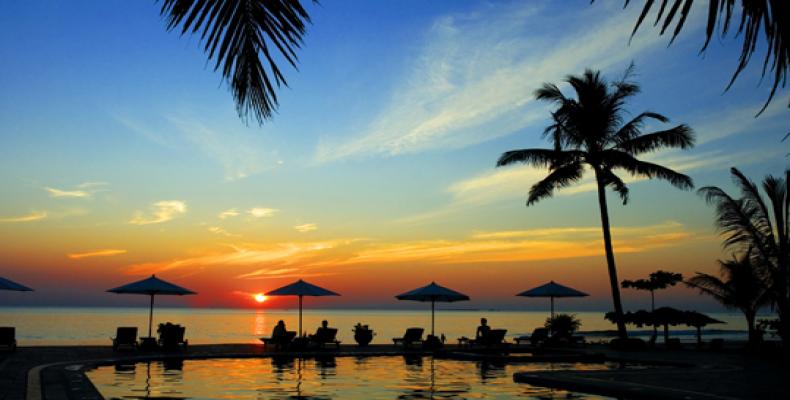London, November 9 (RHC-Barbados Today) – The Caribbean’s tourism sector is now expected to register slower growth in 2017 than the 3.5 per cent projected earlier this year.
Addressing a news conference at the World Travel Market in London this week, Chairman of the Caribbean Tourism Organization (CTO) Dionisio D’Aguilar said that due to the devastating impact of recent hurricanes, the sector was now likely to expand by “between one and two per cent, with a similar growth rate projected for next year”.
Hurricanes Irma and Maria battered the region in September, resulting in several deaths and billions of dollars in damage. Among the hardest hit countries were Barbuda, Dominica, the British Virgin Islands, the Turks and Caicos Islands and Anguilla.
D’Aguilar noted that following “record performances in the first half of 2017, “some of our member countries, and by extension the region, [experienced] the worst of times with the passage of hurricanes Irma and Maria”.
“We began the year growing at a healthy pace of 5.2 per cent between January and June, when compared to the same period last year,” the CTO chairman said, noting that the actual performance was way ahead of the forecasted growth rate of between 2.5 and 3.5 per cent.
D’Aguilar, who is the minister of tourism and aviation in the Bahamas, also said the initial performance was a reflection of the economic stability in the marketplace, the expansion and inauguration of flights by major carriers and a new marketing and product development thrust.
During the first six months of 2017, the region recorded 16.6 million international tourist arrivals, an estimated 800 thousand more than for the same period in 2016, with D’Aguilar pointing out that growth was recorded in all major source markets, except South America, which contracted by 14.3 per cent.
Up to June, the European market had grown by 7.9 per cent, Canada by 6.4 per cent, and despite the weak sterling, the United Kingdom grew by 4.8 per cent, the CTO chairman said.
In the hotel sector, the half-year outcomes reported by STR Global showed that average occupancy increased marginally by 0.2 percentage points to 70.8 per cent, while the average daily room rate rose slightly by 0.2 per cent, moving from US$220.84 in 2016 to US$221.38 in 2017.
Growth in the cruise sector was also quite positive.
“At the end of the first six months of 2017, cruise passenger arrivals to the Caribbean region had reached an estimated 15.3 million, up four per cent over the corresponding period of 2016. This performance represented the largest number of cruise passengers in the region at this time of year.
“Then came the hurricanes . . . that inflicted such damage on some of our member countries, causing such despair! There has been widespread coverage of the damage caused to these countries and territories, the most serious among them being Anguilla, Barbuda, the British Virgin Islands, Dominica, Puerto Rico, both Dutch and French Saint Martin and the US Virgin Islands,” he said, adding that “understandably, this triggered a slowdown, with travel to many of these destinations.
In light of the devastation, the Caribbean Development Bank is projecting that every one per cent reduction in tourist arrivals could cost US$137 million in lost revenue.
CTO’s revised forecast is also based on air travel data provided by United Kingdom based provider OAG which shows that in October, the number of flights to the region fell by 6.7 per cent, while seat capacity contracted by 4.1 per cent.
“Among the worst hit destinations, the frequency of flights to Puerto Rico decreased by 25.1 per cent, Dominica by 13.7 per cent, St Maarten by 12 per cent, the British Virgin Islands by 11.2 per cent, Anguilla by 6.3 per cent and the US Virgin Islands by 5.6 per cent,” the CTO chairman reported.
He also seat capacity to these destinations was adversely affected with St Maarten experiencing a near 50 per cent falloff.
Some of these reductions were influenced by Hurricane Harvey, which hit the US mainland, but most were a direct result of Irma and Maria, the CTO chairman said, while noting that Cuba’s capacity grew by ten per cent despite changes to the schedule.
Regional carriers Caribbean Airlines and LIAT both registered declines in capacity, with LIAT falling by 21.3 per cent and Caribbean Airlines by 9.5 per cent, the CTO official added.
However, D’Aguilar said that overall, air capacity in the region grew by five per cent for the first nine months of 2017 when compared to the same period last year.
“As for post-hurricane tourist arrivals, it is still too early to tell, since the October numbers are not yet in. However, with several of the key cruise destinations, including Puerto Rico, St Maarten and the US Virgin Islands recovering from the impact of the hurricanes, cruise lines made changes to their itineraries to include alternative regional ports which remained open.
“These redeployments have benefited countries such as Curacao, which registered a 138.3 per cent rise in cruise passenger arrivals in September, Jamaica (54.1 per cent), the Cayman Islands and Grenada,” he added.


